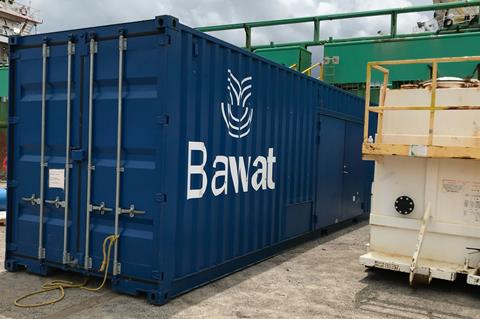Freedom Ballast has conducted shoreside ballast water treatment for a series of offshore support vessels (OSVs) shipped to the US.
The vessels arrived at a US shipyard for repairs and special surveys with approximately 3,500m3 of residual ballast water onboard. The owner chose to use a third-party ballast water reception and treatment provider rather than pay for shoreside disposal.
The OSVs, with low ballast water discharge capacities and numerous small volume ballast tanks, were unable to continuously pump ballast water to the portable ballast water reception facility provided by Freedom Ballast. A temporary buffer tank (providing a surge volume) was used to allow continuous feed to the reception facility. Cross connecting the OSV ballast and cargo systems allowed the ballast water to be discharged through topside piping risers. Flexible hoses were used to connect the OSV discharge headers to the buffer tank. The buffer tank was then connected to the portable ballast water treatment system.
During ballast discharge and treatment, biological samples required by the U.S. EPA Vessel General Permit were collected and analyzed by a local water quality analysis laboratory.
In the US, ballast water management is enforced by US Coast Guard (regulations contained in 33 CFR 151 Subparts C & D) and the EPA’s 2013 VGP. “The US regulations and requirements, already in force, have resulted in numerous fines ranging from unauthorized discharges to improper procedures. Ships have been cited and fined for discharging improperly exchanged ballast water, discharging improperly treated ballast water, and improper record keeping and reporting,” says William H. Burroughs, CEO of Freedom Ballast.
“USCG Port State Control efforts are ramping up post-COVID-19, and we expect to see more findings and fines on the maritime industry for improper ballast water management. Meeting the minimum compliance requirements – installing type approved ballast water treatment system, ballast water management plan, and ballast water record keeping, is proving insufficient to protect the shipowners and operators from non-compliance. While many vessel owners and operators may choose to install an onboard treatment system, it is evident, based on published reports, that 30-50% of these systems fall into disrepair and non-compliance,” says Burroughs.
The operation was a commercial first for Freedom Ballast, signaling what it sees as a growing commercial demand for the service. A small number of emergency treatments have been conducted in the past, but the company sees a big future for is offering of ballast water treatment as a service.
The Freedom Ballast solution is based on the patented Bawat pasteurization process, where the water, including the sediments, is heated to 64°C (minimum) with a 40 second hold time and then discharged. The company is developing ballast water reception facilities for ports on the Mississippi River, Houston Ship Channel, and New York harbor for New York and New Jersey ports.





